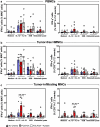Mucosa-associated invariant T cells infiltrate hepatic metastases in patients with colorectal carcinoma but are rendered dysfunctional within and adjacent to tumor microenvironment
- PMID: 28798979
- PMCID: PMC11029177
- DOI: 10.1007/s00262-017-2050-7
Mucosa-associated invariant T cells infiltrate hepatic metastases in patients with colorectal carcinoma but are rendered dysfunctional within and adjacent to tumor microenvironment
Abstract
Mucosa-associated invariant T (MAIT) cells are innate-like T lymphocytes that are unusually abundant in the human liver, a common site of colorectal carcinoma (CRC) metastasis. However, whether they contribute to immune surveillance against colorectal liver metastasis (CRLM) is essentially unexplored. In addition, whether MAIT cell functions can be impacted by chemotherapy is unclear. These are important questions given MAIT cells' potent immunomodulatory and inflammatory properties. Herein, we examined the frequencies and functions of peripheral blood, healthy liver tissue, tumor-margin and tumor-infiltrating MAIT cells in 21 CRLM patients who received no chemotherapy, FOLFOX, or a combination of FOLFOX and Avastin before they underwent liver resection. We found that MAIT cells, defined as CD3ε+Vα7.2+CD161++ or CD3ε+MR1 tetramer+ cells, were present within both healthy and tumor-afflicted hepatic tissues. Paired and grouped analyses of samples revealed the physical proximity of MAIT cells to metastatic lesions to drastically influence their functional competence. Accordingly, unlike those residing in the healthy liver compartment, tumor-infiltrating MAIT cells failed to produce IFN-γ in response to a panel of TCR and cytokine receptor ligands, and tumor-margin MAIT cells were only partially active. Furthermore, chemotherapy did not account for intratumoral MAIT cell insufficiencies. Our findings demonstrate for the first time that CRLM-penetrating MAIT cells exhibit wide-ranging functional impairments, which are dictated by their physical location but not by preoperative chemotherapy. Therefore, we propose that MAIT cells may provide an attractive therapeutic target in CRC and that their ligands may be combined with chemotherapeutic agents to treat CRLM.
Keywords: Chemotherapy; Colon cancer; Immune surveillance; Liver metastasis; MAIT cells; Tumor-infiltrating lymphocytes.
Conflict of interest statement
The authors declare that they have no conflict of interest.
Figures





Similar articles
-
Circulating and tumor-infiltrating mucosal associated invariant T (MAIT) cells in colorectal cancer patients.Sci Rep. 2016 Feb 3;6:20358. doi: 10.1038/srep20358. Sci Rep. 2016. PMID: 26837580 Free PMC article.
-
Mucosa-associated invariant T cells in malignancies: a faithful friend or formidable foe?Cancer Immunol Immunother. 2018 Dec;67(12):1885-1896. doi: 10.1007/s00262-018-2132-1. Epub 2018 Feb 22. Cancer Immunol Immunother. 2018. PMID: 29470597 Free PMC article. Review.
-
Human liver CD8+ MAIT cells exert TCR/MR1-independent innate-like cytotoxicity in response to IL-15.J Hepatol. 2020 Sep;73(3):640-650. doi: 10.1016/j.jhep.2020.03.033. Epub 2020 Apr 2. J Hepatol. 2020. PMID: 32247824
-
MR1-Restricted MAIT Cells From The Human Lung Mucosal Surface Have Distinct Phenotypic, Functional, and Transcriptomic Features That Are Preserved in HIV Infection.Front Immunol. 2021 Apr 9;12:631410. doi: 10.3389/fimmu.2021.631410. eCollection 2021. Front Immunol. 2021. PMID: 33897687 Free PMC article.
-
A Role for MAIT Cells in Colorectal Cancer.Front Immunol. 2020 May 20;11:949. doi: 10.3389/fimmu.2020.00949. eCollection 2020. Front Immunol. 2020. PMID: 32508830 Free PMC article. Review.
Cited by
-
Biased MAIT TCR Usage Poised for Limited Antigen Diversity?Front Immunol. 2020 Aug 18;11:1845. doi: 10.3389/fimmu.2020.01845. eCollection 2020. Front Immunol. 2020. PMID: 33013835 Free PMC article. Review.
-
TIME Is Ticking for Cervical Cancer.Biology (Basel). 2023 Jun 30;12(7):941. doi: 10.3390/biology12070941. Biology (Basel). 2023. PMID: 37508372 Free PMC article. Review.
-
Mucosal-associated invariant T cells and disease.Nat Rev Immunol. 2019 Oct;19(10):643-657. doi: 10.1038/s41577-019-0191-y. Nat Rev Immunol. 2019. PMID: 31308521 Review.
-
Tumor-infiltrating mucosal-associated invariant T (MAIT) cells retain expression of cytotoxic effector molecules.Oncotarget. 2019 Apr 19;10(29):2810-2823. doi: 10.18632/oncotarget.26866. eCollection 2019 Apr 19. Oncotarget. 2019. PMID: 31073372 Free PMC article.
-
Mucosal-associated invariant T cells in hematological malignancies: Current knowledge, pending questions.Front Immunol. 2023 Mar 20;14:1160943. doi: 10.3389/fimmu.2023.1160943. eCollection 2023. Front Immunol. 2023. PMID: 37020559 Free PMC article. Review.
References
-
- El-Shami K, Oeffinger KC, Erb NL, Willis A, Bretsch JK, Pratt-Chapman ML, Cannady RS, Wong SL, Rose J, Barbour AL, Stein KD, Sharpe KB, Brooks DD, Cowens-Alvarado RL. American Cancer Society colorectal cancer survivorship care guidelines. CA Cancer J Clin. 2015;65(6):428–455. doi: 10.3322/caac.21286. - DOI - PMC - PubMed
-
- Manfredi S, Lepage C, Hatem C, Coatmeur O, Faivre J, Bouvier AM. Epidemiology and management of liver metastases from colorectal cancer. Ann Surg. 2006;244(2):254–259. doi: 10.1097/01.sla.0000217629.94941.cf. - DOI - PMC - PubMed
MeSH terms
Grants and funding
LinkOut - more resources
Full Text Sources
Other Literature Sources
Medical

